People who reside in the city or near the streets have often have privacy issues. A house isn’t homey if you are frequently disturbed by cars on the road or by people walking by or through your yard. If you need some secluded space and do not want to spend too much money on iron fencing panels or wooden perimeter lines, consider planting privacy bushes.
Many shrubs grow tall enough to block the view of nosy strangers lounging around the house. Generally, fast growing bushes can provide you a quick screen within a couple of months, and slow growing shrubs offer a thicker screen as they mature.
Shrubs are smaller than trees, typically growing to twelve feet or less. Unlike trees, shrubs or bushes have thick foliage from top to bottom, leaving no space or holes for people to peek through.

- Get Rid of Nosy Neighbors with Privacy Plants
- Benefits of Planting Privacy Bushes
- Caring for Privacy Bushes
- Pruning, Trimming, and Clipping Privacy Bushes
- Thuja Green Giant (Thuja standishii x plicata) – Fast Growing Privacy Bushes
- Green Columnar Juniper (Juniperus chinensis)
- Emerald Green Arborvitae (Thuja occidentalis)
- Fast Growing Hedges – Leyland Cypress (Cupressocyparis leylandii)
- Redtwig dogwood (Cornus sericea)
- Lo and Behold Butterfly Bush (Buddleia hybrid) – Flowering Privacy Bush
- American Holly (Ilex opaca)
- Cold Hardy Bush – White Panicle Hydrangea (Hydrangea paniculata)
- Dwarf Burning Bush (Euonymus alatus 'Compactus')
- Compact Japanese Holly (Ilex crenata) – Evergreen Shrubs for Privacy
- Summer Blooming Wine Ninebark (Physocarpus opulifolius)
- Mosquito Deterring Shrub – European Pennyroyal (Mentha pulegium)
- Lynwood Gold Forsythia (Forsythia x intermedia)
- American Beautyberry (Callicarpa americana) – Privacy Fruit Trees
- Chinese Fringe Flower (Loropetalum chinense)
- Sensation Lilac (Syringa vulgaris) – Deer Repelling Shrub
- Doublefile Viburnum – (Viburnum plicatum var. tomentosum)
Get Rid of Nosy Neighbors with Privacy Plants
Here, you will find information about the characteristics and planting requirements for bushes and shrubs. These details will help you pick the right privacy plant species suitable for your needs.
We have a selection of different shrubs and bushes to help you shield your property from nearby busybodies. Choosing what works for your yard depends on where you live and the look you want to achieve. If you have problems with rodents or other creatures that like to nibble your foliage, take that into consideration, too.
Ask yourself, “Are spirea deer resistant? Do squirrels like holly berries?” Answering these types of questions ensures that you get plants that make an effective hedge and remain that way for years to come.
Benefits of Planting Privacy Bushes
Privacy bushes and shrubs for perimeter screening are amazingly versatile. They provide many benefits, aside from giving you a secluded retreat. For instance, some shrubs keep the area cool, and others work as effective windbreaks during the cold months.
Flowering privacy shrubs also provide your surroundings with seasonal beauty with unique color, shapes or textural bark and stems. Some bushes are also insect repellents and deer deterrents.
Other shrubs bear edible fruits for snacks or bird food. Many have juicy berries that attract songbirds during cold months when wildlife food is short in most areas.
Caring for Privacy Bushes
The best bushes for privacy hedges are those that work with the kind of care you can give them. Don’t choose a high maintenance shrub if you don’t have the time to meet its needs.
Each plant has specific needs and requirements to mature appropriately. Typically, most privacy shrubs grow best in moist, fertile soil.
But, if you live where there is not have an ideal planting environment, consider getting planting mix or other organic alternatives. Adequate watering is also critical.
Know if the plant you choose needs a lot of watering or not so that you can avoid overwatering effects and vice versa. Some privacy bushes are drought tolerant, but still, they will need watering from time to time to survive.
Lastly, if you have tall trees, check if the privacy bushes that you select can live in the shade. Your trees might cast a shadow over your shrubs and possibly hinder their growth. In general, most plants for privacy need a lot of sunlight exposure.

Pruning, Trimming, and Clipping Privacy Bushes
Planting hedges and low bushes around the house is a perfect option for low screening. For tall shrubs and other fast-growing plant species, pruning may be necessary.
If you want to clip them, remember to keep the top of the hedge narrower than the base. This habit will prevent the plant from thinning and will avoid open spaces at the bottom part of the plant, where you want the foliage to be as dense as possible.
Thuja Green Giant (Thuja standishii x plicata) – Fast Growing Privacy Bushes

Thuja green giants belong to the group of evergreens called conifers. Conifers do not have flowers but produce cones instead.
They are famous for use as perimeter plants because they are low maintenance, can cover large yards, and they mature close to each other. Because of these features, they are sometimes recognized as the best evergreen bushes for privacy.
Aside from its superb performance in enclosing the yard and making the perfect shrubs for wind screening, Thujas are resistant to common tree diseases and are very adaptable to different soil or weather conditions.
These green giants are fast growing privacy plants and only require little water. Pruning is not a problem; plant them a few feet apart, and in no time, you can have a concealed backyard.
Green Columnar Juniper (Juniperus chinensis)
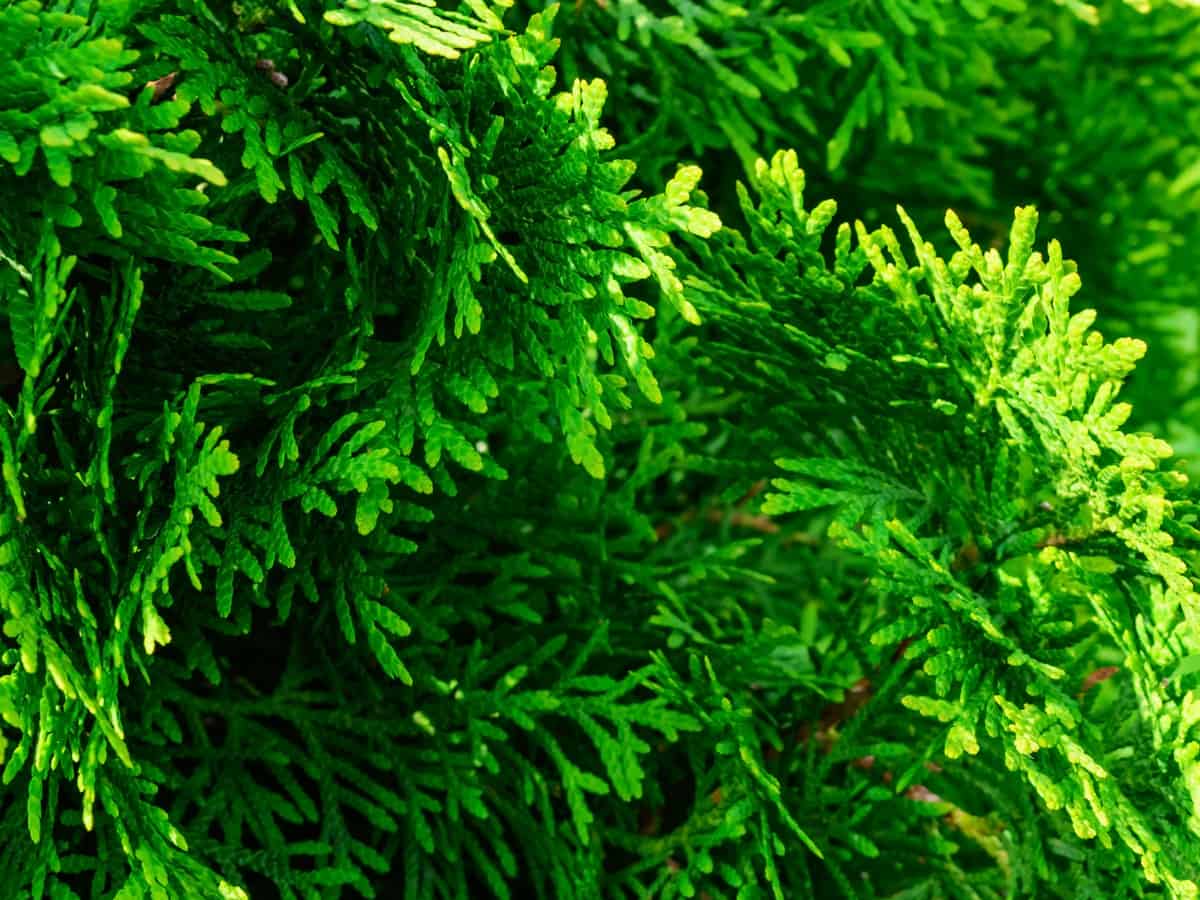
The green columnar juniper is a durable evergreen that offers a perfect privacy screen for areas where other evergreens won’t thrive. It is not picky, and it can grow even in poor, rocky soil. It can also tolerate drought and heat. The height can peak up to fifteen feet or more in a short time.
The colors of the leaves are rich dark-green and are not quickly burned in the sun or cold. If you want a dense hedge for screening, easy-care accents, and putting up greenery, the green juniper is an ideal option.
You can prune or clip the juniper or let it grow naturally. Once established, you will find that this is one of the easiest privacy bushes to grow, and the perfect option if you do not have a lot of time for gardening.
Emerald Green Arborvitae (Thuja occidentalis)
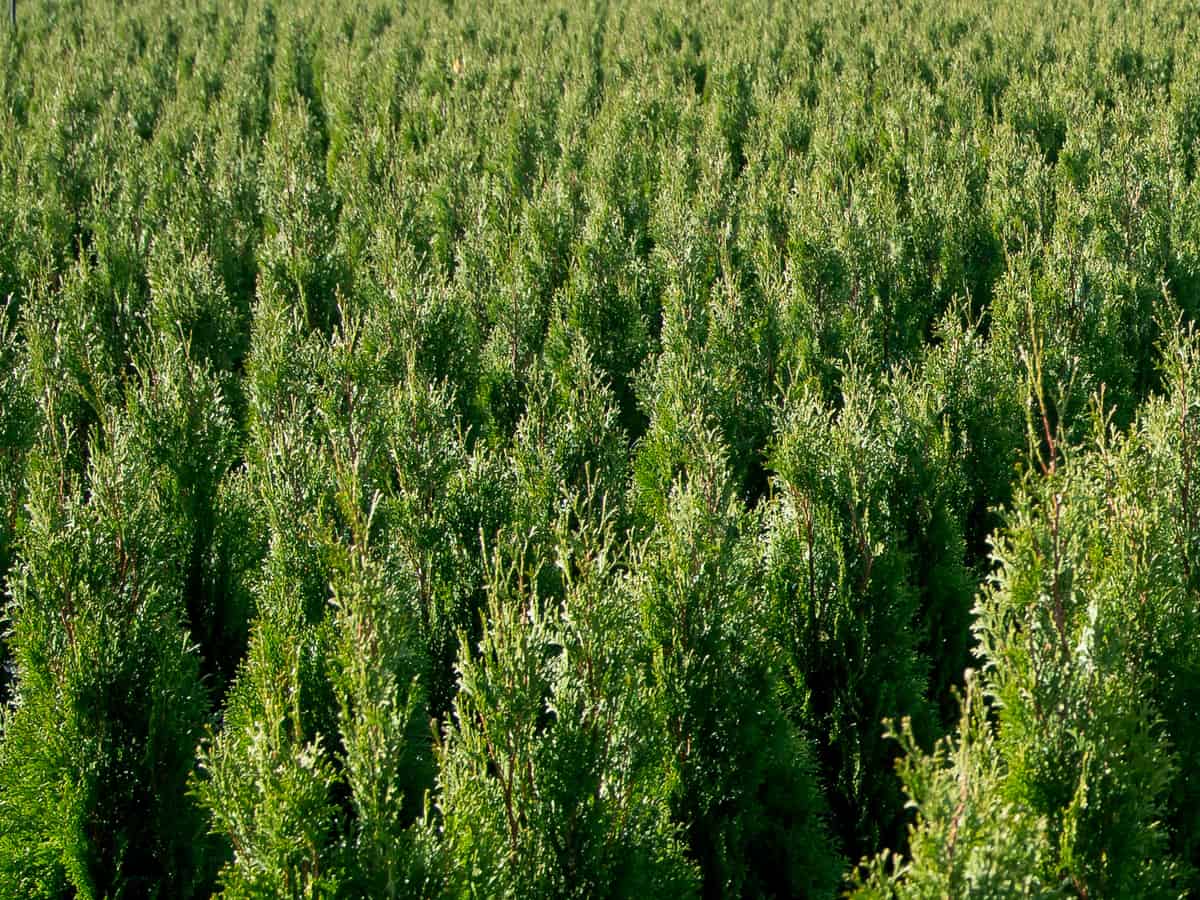
If you want privacy trees for every purpose, the emerald green arborvitae is the best pick. Unlike Thuja Green Giants, these trees only grow from eight to twelve feet.
They can grow in smaller spaces as a tall privacy fence without the hard work of regular trimming and other maintenance. To grow them as hedges, plant them three feet apart.
Fast Growing Hedges – Leyland Cypress (Cupressocyparis leylandii)

The Leyland Cypress is a fast growing privacy hedge that can grant you a secluded retreat. It is one of the most common fast growing evergreen trees in the United States. It grows around three to five feet every year and can thrive within USDA plant hardiness zones 6-10. The green foliage of the Leyland Cypress will provide you with a pleasing feathery look.
Leyland Cypress prefers full sunlight and can tolerate some shade and they make wonderful trees for privacy. Furthermore, Leyland Cypress trees are drought tolerant and grow best in fertile, moist soil. Don’t overwater to avoid yellowing of the foliage.
This tree is susceptible to many different diseases and garden pests so frequent monitoring is required to ensure that your Leyland Cypress doesn’t succumb to these problems. For fast growing shrubs that offer beauty and privacy, as well as a pleasant aroma, you can’t go wrong with the Leyland Cypress. Plant one or several to add interest to the perimeter of your yard.
Redtwig dogwood (Cornus sericea)

The redtwig dogwood is an attractive year-round shrub that can reach a mature height of three to twelve feet tall, depending on the location and the amount of pruning. It is cultivated mainly for the bare twigs’ red color in the winter, which looks striking against a white snowy background.
These low-maintenance privacy shrubs also make an attractive informal hedge. It is especially useful if your garden or yard has water nearby like a pond because it is perfect for boundary plantings. If you also need a perfectly natural way to mark your property boundary, redtwig dogwood is a lovely choice.
Lo and Behold Butterfly Bush (Buddleia hybrid) – Flowering Privacy Bush

If you are looking for the best bushes for front yard or lawns, consider planting a butterfly bush. Aside from the fact that it has pink to reddish spike-shaped flowers, its grey-green foliage is also beautiful, as it intensifies the opposing contrast of colors between the leaves and the flowers.
These plants easily thrive in a sunny or dry place with well-drained, sandy soil. They grow quickly to a mature height of only two feet, so for you to have a medium height privacy bush, you might have to get a planter or pot.
Either way, you will love these flowering shrubs because they always have flowers. They also produce a honey-like fragrance that attracts butterflies, where they feed on the sweet nectar.
American Holly (Ilex opaca)
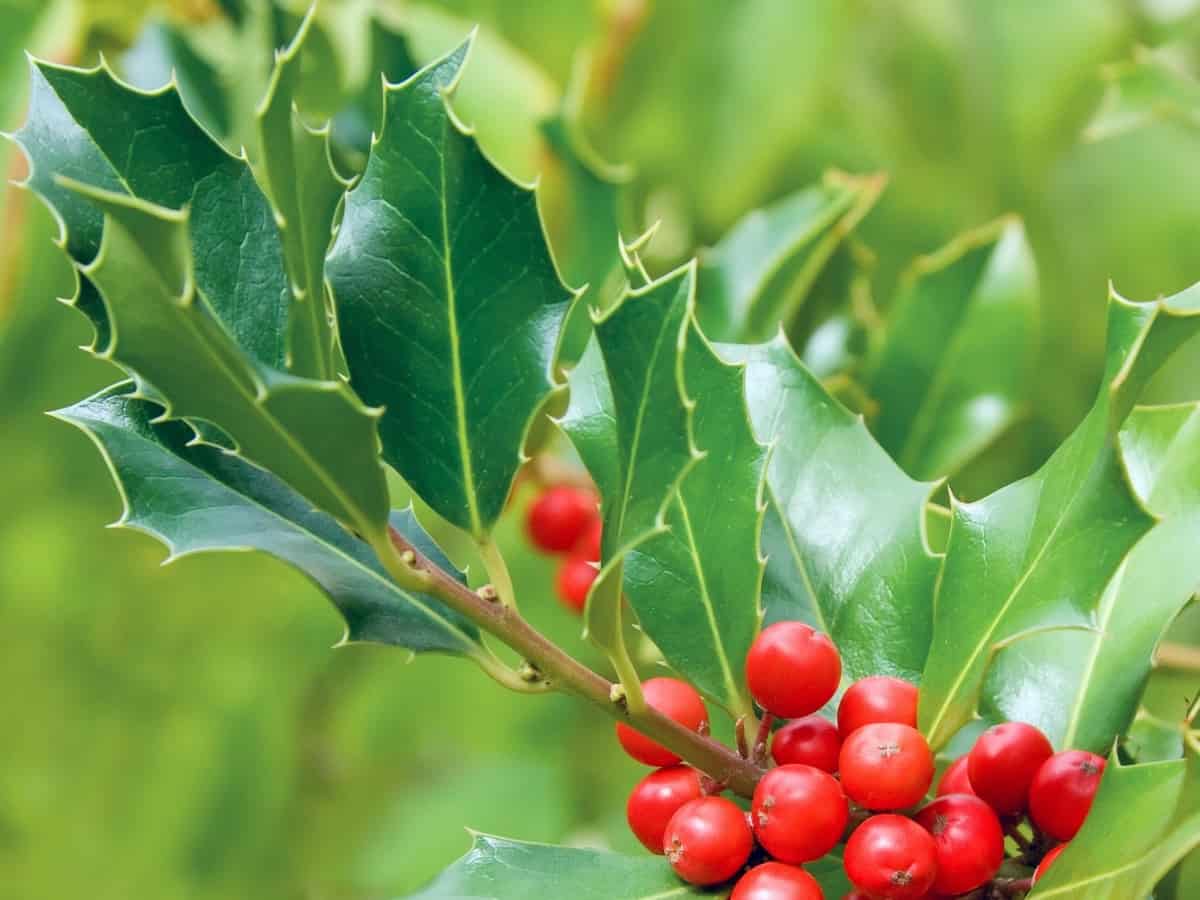
You might think American Holly is a Christmas plant with red berries or winter berries, but what you might not realize is that it is a stunning deciduous shrub. In the spring, this privacy plant bestows exquisite white flowers.
Once winter arrives, prepare yourself to see red berries against green leaves, a stunning look that makes the holly the tree of the American winter.
The Pennsylvania Horticulture Society awarded this hardy tree with a Gold Medal for its ability to survive in different environments. It grows in full or partial shade, and it is also tolerant to drought. It does not require a lot of trimming or pruning and is resistant to pests and diseases.
Cold Hardy Bush – White Panicle Hydrangea (Hydrangea paniculata)
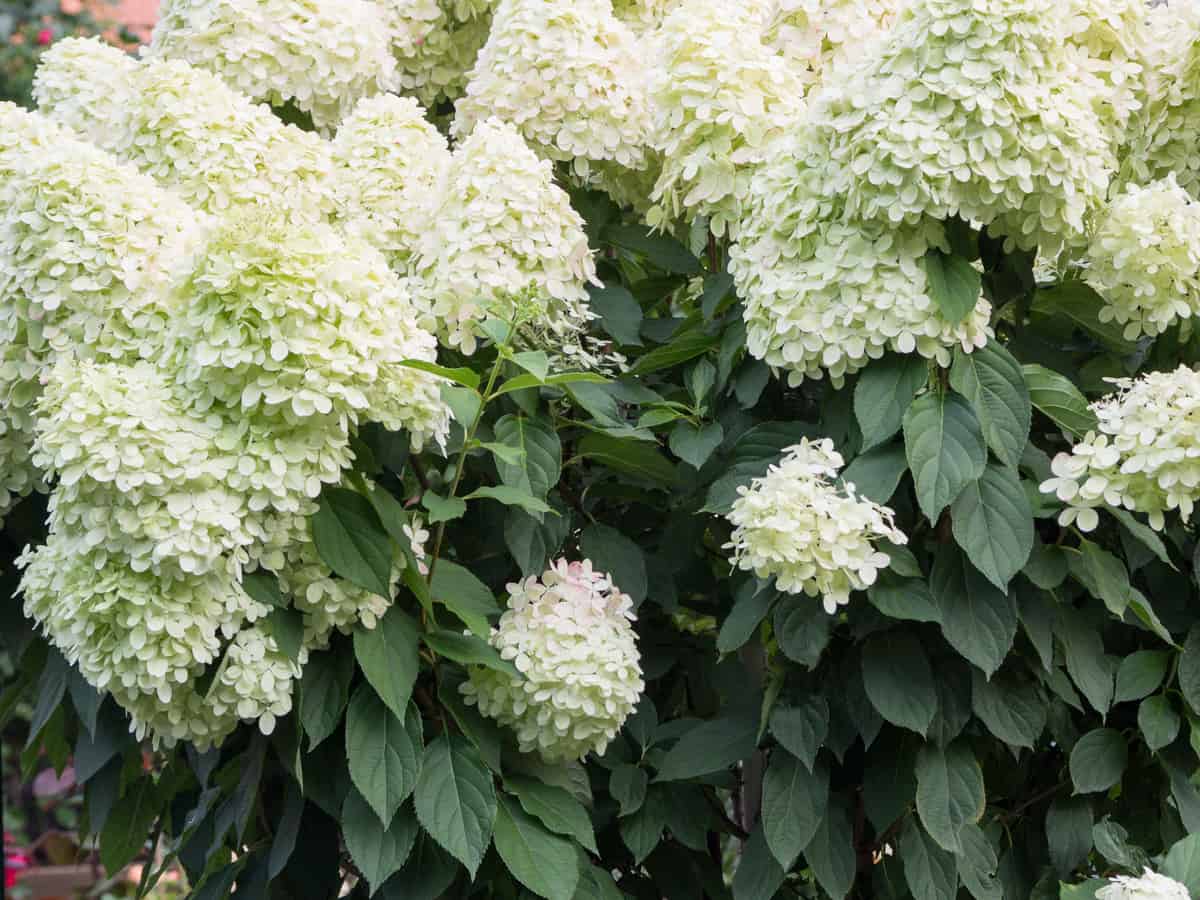
White Panicle Hydrangeas are best for smaller gardens in cold areas. They have a large rounded clump of stunning white flowers. Their stems are very durable, keeping the flower heads upright and preventing them from flopping, so they always look great.
Like other types of bushes for front of house, hydrangeas are of moderate size, peaking up to only six feet tall. They survive just as well in warmer regions, where the flowers bloom in early summer.
These bushes are easy to grow anywhere because they are heat resistant, sun-tolerant, and not picky when it comes to soil type. They can live well even in partial shade or full sun and usually are disease or pest free.
Dwarf Burning Bush (Euonymus alatus ‘Compactus’)

The Dwarf Burning Bush is a deciduous shrub that matures compactly. In the late season landscape, it creates a sensational ornamental accent due to its awe-inspiring foliage. Its dark green leaves turn into the most brilliant bright red or scarlet late fall color. Mature height is about four feet tall.
They are relatively straightforward to care for – all you need is a sunny spot with properly-drained soil. To care for burning bush shrubs, water them regularly, especially during warmer months. Prune only when necessary and enjoy their brilliance against evergreen shrubs.
Compact Japanese Holly (Ilex crenata) – Evergreen Shrubs for Privacy

The Compact Japanese Holly is a remarkable substitute for boxwood in humid or warmer regions where boxwood cannot survive. It has small, evergreen foliage and grows much faster than boxwood plants.
These fast-growing bushes can grow up to five feet tall, which makes them excellent hedges. This holly is easy to care for because this species is tolerant of humidity, heat, and drought. So, if you want fast growing shrubs or ground covering plants that won’t take too much of your attention, consider these shrubs.
Summer Blooming Wine Ninebark (Physocarpus opulifolius)

Summer Blooming Wine Ninebark has been around for decades. However, many people, even long-time gardeners, do not know a lot about this native American shrub. Offering four-season interest, these easy perennial plants grow six to eight feet tall.
The ninebark produces beautiful white flowers in spring that turn into berries over a couple of weeks.
As a hardy shrub, it thrives in cold temperatures and grows in various types of soil, which makes it unique because other quickly growing bushes are picky with planting soil conditions. This shrub’s upright arching form is lovely, making it the perfect solution for transforming mundane corners of any garden.
Mosquito Deterring Shrub – European Pennyroyal (Mentha pulegium)

European Pennyroyal is a plant that is scientifically known as Mentha pulegium. It also belongs to in the mint family and is one of the most common bushes that repel mosquitoes. Aside from that, its leaves are edible. Dry or fresh leaves harvested from pennyroyals can be extracted to use as condiments or tea.
Pennyroyals parade their flowers in August to October, and the seeds ripen during late fall. They grow in various types of soil in any acidity level and can survive in partial to no shade.
Lynwood Gold Forsythia (Forsythia x intermedia)
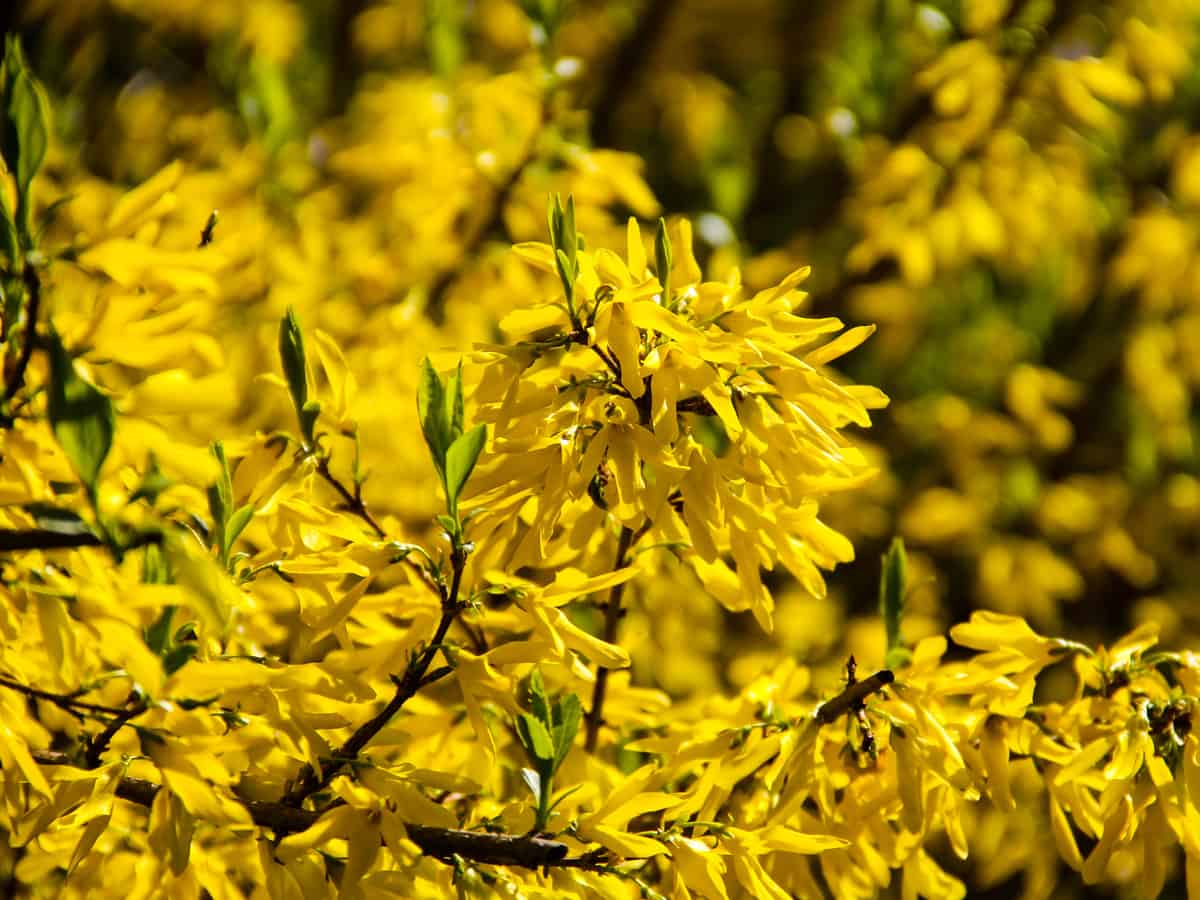
Lynwood Gold Forsythia is one of the first blooming shrubs in early spring or late winter. It bursts into glorious yellow-golden large flowers before any leaves appear, even when there are snow patches still lying around.
This plant grows up to six or nine feet horizontally and vertically. It can grow in clay soil or other types of soil where most shrubs won’t grow. The Forsythia can also thrive in harsh city-life conditions and serves as an excellent flowering privacy screen hedge in full yellow bloom every spring and as a rich-green barrier afterward.
American Beautyberry (Callicarpa americana) – Privacy Fruit Trees
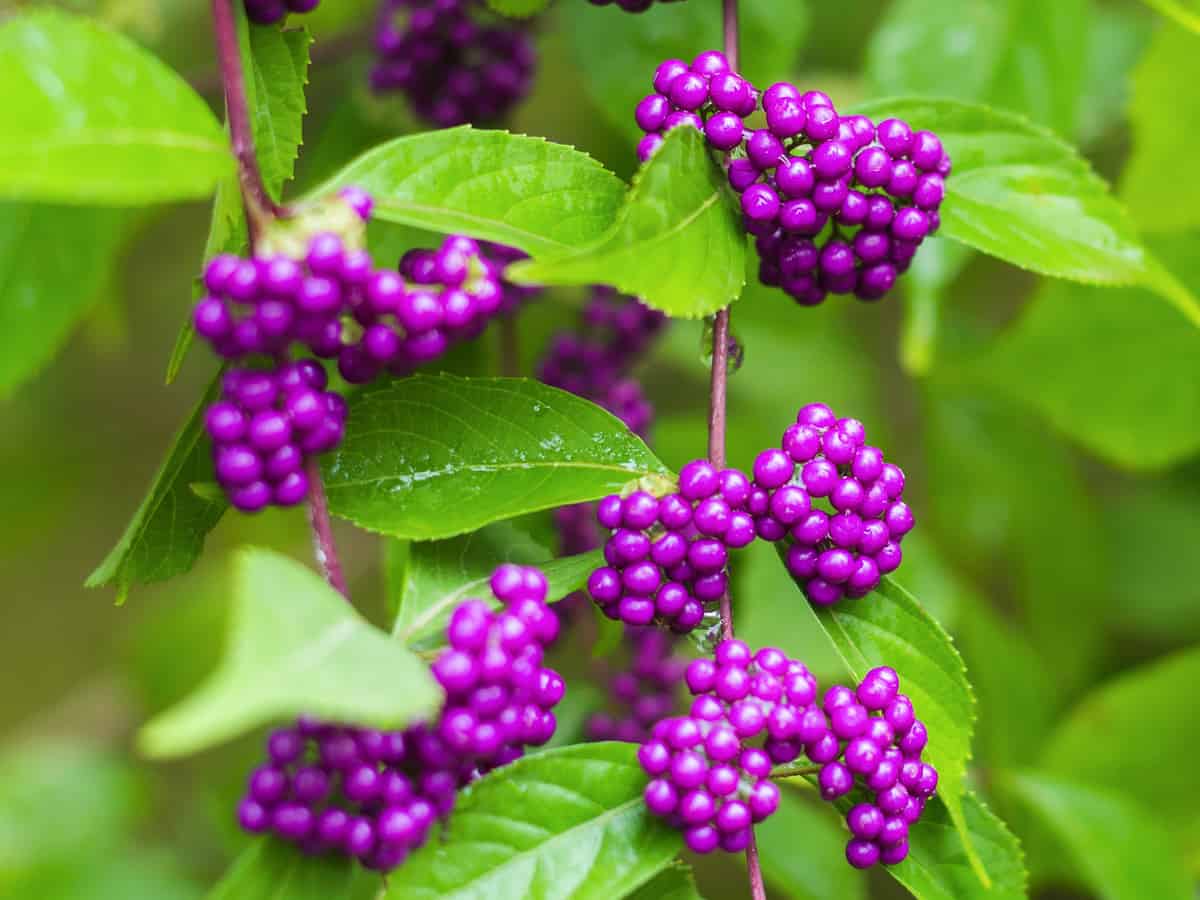
American Beautyberry, also known as French mulberry or simply beautyberry, is a deciduous shrub that is common in the southeastern United States. It typically matures to a height of four to five feet, and many gardeners love it for its spectacular bright purple berries.
For a privacy hedge that also serves as a fruit tree, you’ll enjoy seeing beautyberry’s fruit hanging on the stem in plump clusters. The pink spring flowers bloom until mid-summer. Although some people think they are poisonous, beautyberry is edible.
It can grow in partial shade and moist conditions. It is a large understory foliage shrub with an arching form that makes it useful as a screen in a garden or greenhouse setting. You can also leave it to grow naturally into a tall shrub.
Furthermore, researchers found a compound called callicarpenal in the leaves of beautyberry. It is thought that this chemical can be used as a natural insect repellent.
Chinese Fringe Flower (Loropetalum chinense)

Chinese fringe flower is a small genus of shrub species in the witch-hazel family. It has spider-like blooms that show starting in late winter or early spring. It is native to woodlands of China, the Himalayas, and Japan.
To plant Chinese fringe flower, select an area with partial shade rich in humus and well-drained soil. It is generally problem-free and is perfect for use as a shrub border. You can either grow it in pots, planters or directly in the ground.
Sensation Lilac (Syringa vulgaris) – Deer Repelling Shrub
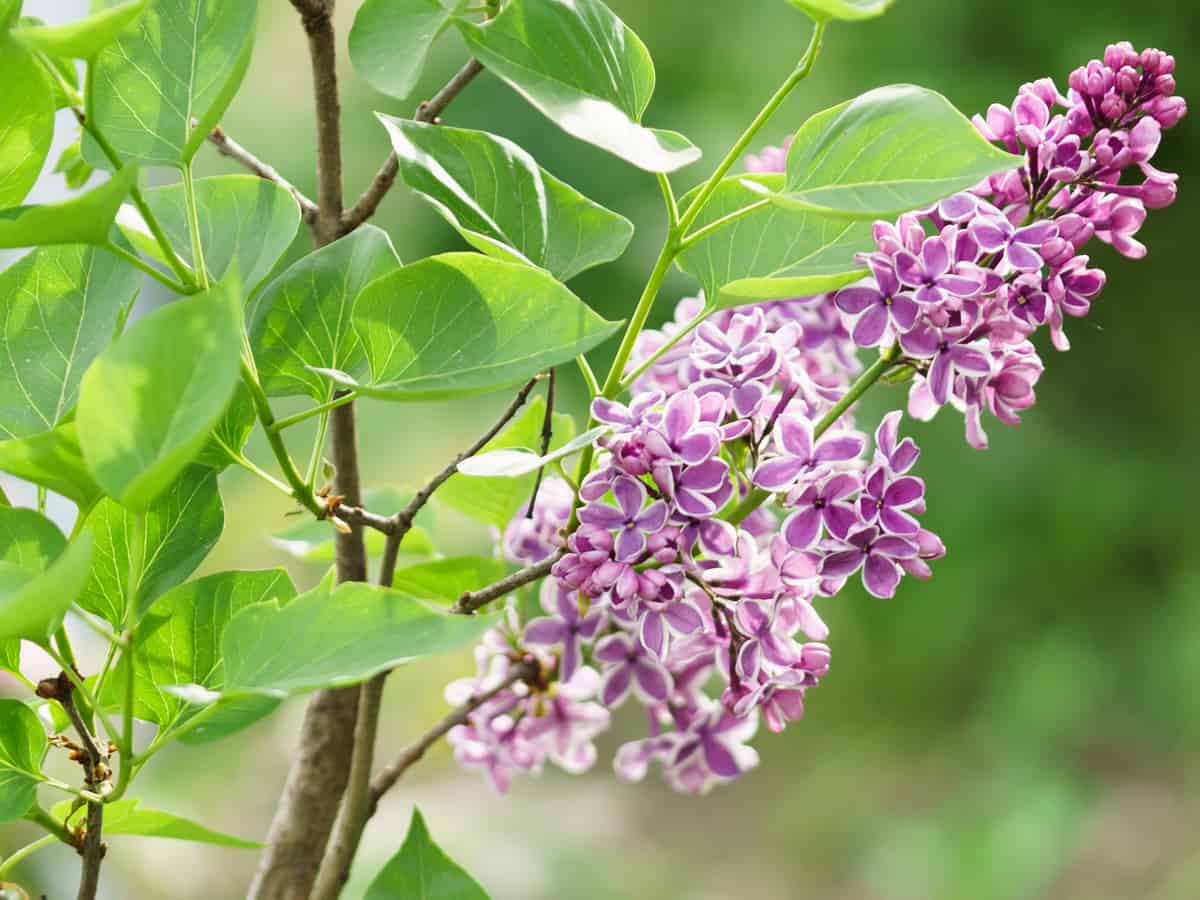
If you need quickly growing bushes to give you privacy at home, you might like Sensation Lilacs. They will not only give you the seclusion you need from nosy neighbors but, they will also deter wild animals. With lilacs, you have a natural deer repellent recipe. So, to keep them away from your home, plant them around the perimeter.
Another feature that many people love about lilac is that they are fire retardant, which means they are perfect for planting around homes that are susceptible to wildfires.
Growing lilacs involves using reasonably fertile soil that is neutral or at least slightly non-acidic and well-drained. Also, these shrubs prefer full sun, so pick a spot where no tall trees overshadow your lilacs.
Doublefile Viburnum – (Viburnum plicatum var. tomentosum)
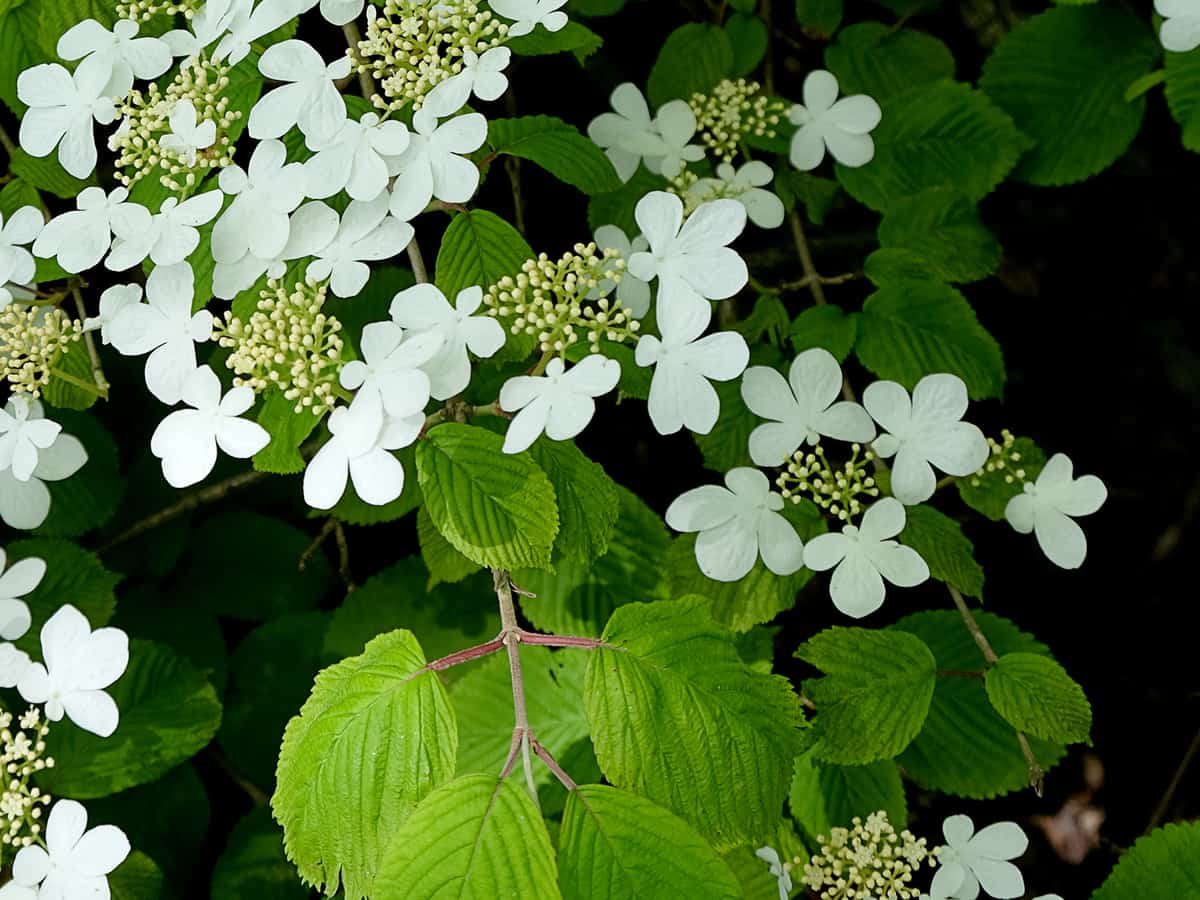
The Doublefile viburnums are medium-sized shrubs that bloom with beautiful little white flowers in the springtime, typically from April to May. They have dark green foliage on a dense, multi-stemmed bush that is oval.
In autumn, the green leaves turn to beautiful burgundy red. The blooms group together in flat clusters, of about two to four inches wide, which gives way to small fruits that bear seeds.
These color changing shrubs have many applications for landscaping. You can use them as single specimen plants or plant them in groups to form shrub screens or hedges and perimeter borders. They are incredibly easy-to-care-for and do not have many problems in terms of pest and plant diseases.
Privacy at home is essential. Expensive fencing materials like wood and iron panels are not necessary to provide the seclusion needed for a solitary retreat. Sometimes, you only need to let the beauty of hedges and privacy shrubs enfold you and your home. Many shrubs and bushes mature quickly, providing you the privacy that you desire in no time.
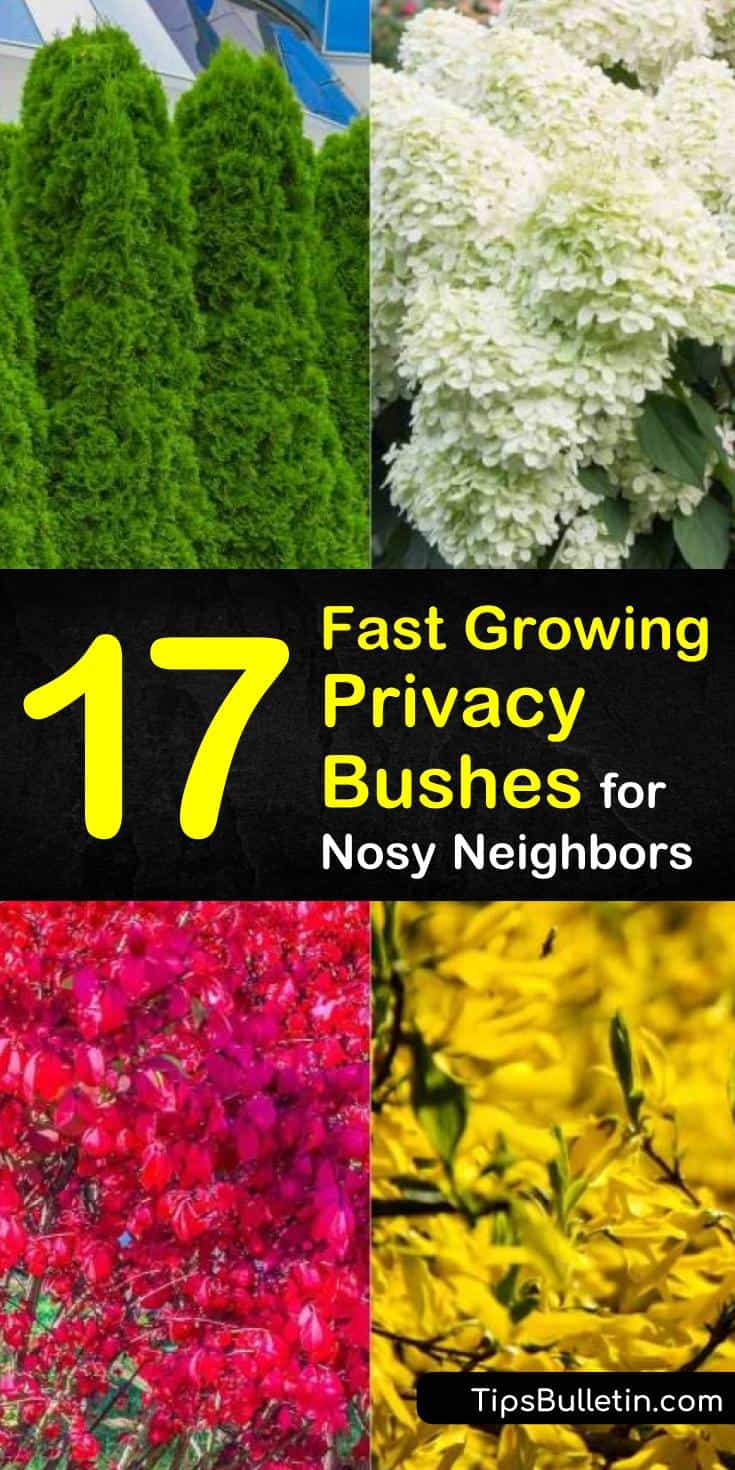
We hope that you enjoyed reading about privacy bushes that you can plant around the perimeter of your yard. If you found the information on the best bushes for privacy interesting, please share our bush plant suggestions with your family and friends on Pinterest and Facebook.